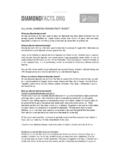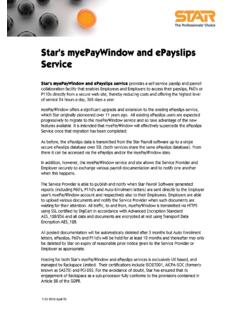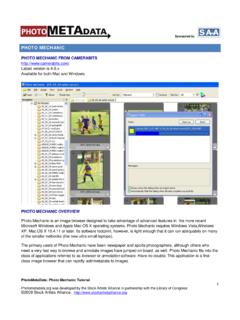Transcription of THE DIAMOND INDUSTRY FACT SHEET
1 FOR MEDIA USE THE DIAMOND INDUSTRY fact SHEET How large is the DIAMOND INDUSTRY ? Diamonds are one of the world s, and specifically Africa s, major natural resources. An estimated US$13 billion worth of rough diamonds are produced per year, of which approximately US$ billion are from Africa (approximately 65%). The DIAMOND INDUSTRY employs approximately ten million people around the world, both directly and indirectly, across a wide spectrum of roles from mining to retail. Global DIAMOND jewellery sales continue to grow, increasing three-fold in the past 25 years, and are currently worth in excess of US$72 billion every year. What are diamonds used for? Diamonds have two main uses: in jewellery (due to their rarity and beautiful appearance) and in INDUSTRY (due to their unique molecular properties). In terms of quantity, about 30% of diamonds are of gem quality and are distributed to experts for cutting, polishing and jewellery manufacture.
2 The remaining 70% of diamonds are sold for industrial applications including cutting, drilling, grinding and polishing in industrial applications. Why are diamonds unique? Diamonds have been used throughout history as a symbol to express emotions - love, affection and commitment - and are often given to celebrate special occasions that are also unique, such as weddings, births and anniversaries. In many cultures diamonds are considered to be the ultimate jewel. Diamonds are desirable to consumers because they: Hold deep emotional meaning Are one of the Earth s most precious creations Are unique, just like the person wearing them Were born at the beginning of time and will last for eternity Diamonds started to form inside the Earth billion years ago due to extreme heat and pressure. In this environment, the carbon atoms in a DIAMOND uniquely bond in pyramid structures; it is this composition which makes them so vital for industrial applications.
3 Diamonds are: The hardest natural material known to man The most effective heat conducting material, which also expands very little when subjected to high temperatures, unlike most other conducting materials Resistant to most acids and alkalis What is the process that brings diamonds to consumers? The DIAMOND jewellery supply chain (known as the DIAMOND pipeline) is the process that brings diamonds from the earth to consumers. It has several different stages: Exploration Diamonds are found in many countries around the world, but the majority (approximately 65%) are found in Africa. The main DIAMOND producing countries are: o Angola o Australia o Botswana Exploration Mining Sorting Cutting & polishing Jewellery Manufacturing Retailing FOR MEDIA USE o Canada o Democratic Republic of Congo o Namibia o Russia o South Africa Diamonds often exist within kimberlite rock, which is a mineral located often beneath overburden (such as sand, soil or glacier).
4 DIAMOND prospectors, who explore for these valuable mineral deposits, often search for kimberlite (the host rock for diamonds) by testing the ground for changes in magnetic fields. Mining Once diamonds are detected, there are different types of mining operation used to extract them depending on the environment in which they are found. The majority of diamonds are extracted on an industrial scale by: o Open pit mining (excavation to reach diamonds on the surface of the ground) o Underground mining (excavation up to, and in some instances, over 1km below ground) Following extraction, the ore containing the rough diamonds goes through many stages of crushing and processing before it can be sorted and classified. Diamonds are also extracted from alluvial deposits, where they are removed from sand, gravel and clay that has been naturally transported by water erosion and deposited along either the banks of a river, the shoreline or on the bed of the ocean.
5 This process is called alluvial mining and is undertaken on an industrial scale by: o Coastal and inland mining (removal of overburden, such as sand and soil, to find diamonds) o Marine mining (excavation of diamonds from the seabed) DIAMOND mining on a non-industrial scale is undertaken involving individuals, families and communities and using the most basic equipment, such as sieves and pans this is known as artisanal mining. Sorting Once processed at the mine, rough diamonds are delivered to sorting experts to be sorted and valued into different categories in preparation for sale. There are thousands of different categories into which diamonds can be sorted, dependent on size, shape, quality and colour. The majority of diamonds fall within a range of standard colours from colourless to faint yellow or brown tints. Some very rare diamonds, known as fancies , are bright colours, such are pink, blue or green. A perfectly transparent DIAMOND with no colour or hue is considered to be the purest, but all rough diamonds have some distinguishing marks, known as inclusions, which make each one unique.
6 The best quality diamonds in terms of colour and clarity are distributed to the gem market with an accompanying Kimberley Process certificate to prove that they are from conflict free sources (refer to Kimberley Process section below for further details on this process). The remainder are used for industrial purposes, such as cutting and drilling. Cutting and polishing Gem quality diamonds are usually distributed to one of the main DIAMOND cutting and trading centres in Antwerp, Mumbai, Tel Aviv, New York, China, Thailand or Johannesburg. Once they arrive at the DIAMOND centres, experts (known as diamantaires ) cut and polish the rough diamonds into shapes, such as the round brilliant, the oval, the pear, the heart and the emerald. Polishing follows cutting, before the diamonds are again classified by their cut, colour, clarity and carat weight also known as the Four Cs . These diamonds are typically sold to DIAMOND wholesalers or DIAMOND jewellery manufacturers in one of the 24 registered DIAMOND exchanges (known as bourses) located across the world.
7 Jewellery manufacturing Wholesalers or manufacturers buy relatively small amounts of unset, polished diamonds. Wholesalers sell these to jewellery designers, manufacturers or retailers. Manufacturers will produce DIAMOND jewellery designed and commissioned by a retailer or other jewellery designer. They may also create jewellery, designed by in-house teams, and sold direct to retailers. The System of Warranties is used as a declaration on the invoice for each transaction of polished diamonds to assure INDUSTRY purchasers and consumers that their diamonds are from conflict free sources (refer to System of Warranties section below for further details on this system). FOR MEDIA USE Retailing The final stage of the DIAMOND pipeline is when DIAMOND jewellery is sold by retailers to the consumer. The value of DIAMOND jewellery sold each year is approximately US$72 billion, which includes the cost of the diamonds, precious metals and other gems.
8 The USA represents the largest market (50%), followed by Japan (15%), Italy (5%), India (3%), China (2%), The Gulf (2%) and other countries (23%). According to independent research, DIAMOND jewellery is the most highly sought-after category of luxury goods, both by women for themselves and by men for gifts. How does the DIAMOND INDUSTRY promote responsible trading practices? To promote the trading of diamonds from legitimate sources and to ensure that consumers can be confident in their DIAMOND jewellery purchases, governments, NGOs and the international DIAMOND INDUSTRY have worked together to implement a certificate of origin system, known as the Kimberley Process: The Kimberley Process is a certification system that prevents diamonds from an area of conflict entering the legitimate DIAMOND supply chain. The Kimberley Process ensures that only rough diamonds accompanied by a government-issued certificate can be imported and exported, providing an assurance that the diamonds are from conflict free sources.
9 Under this United Nations mandated system, only countries that are part of the Kimberley Process can import or export rough diamonds. Today, 74 countries are members of the Kimberley Process, ensuring that more than 99% of diamonds are from conflict free sources. Anyone who imports or exports rough diamonds between these countries without a Kimberley Process certificate is breaking the law. In addition to the Kimberley Process, the System of Warranties was developed by the World DIAMOND Council (WDC) to extend the Kimberley Process conflict free assurance to polished diamonds and provide a means by which consumers can be assured their diamonds are from conflict free sources. Its principal element is a declaration on the invoice accompanying every transaction (apart from the transaction directly to the consumer) of polished diamonds that declares the diamonds are not involved in funding conflict and are in compliance with United Nations resolutions.
10 The System of Warranties provides assurance that diamonds are from conflict free sources all the way to the DIAMOND jewellery retailer. CIBJO, the World Jewellery Confederation, is an international confederation of national jewellery trade organisations with 40 nations represented. In addition to the national members there are 33 associate members from the commercial organisations. Founded in 1926, CIBJO's purpose is to encourage harmonisation, promote international cooperation in the jewellery INDUSTRY , and to consider issues which concern the trade worldwide. Foremost among these is to protect consumer confidence in the INDUSTRY . The Council for Responsible Jewellery Practices (CRJP, the Council ) was founded in May 2005 with Members from the DIAMOND and gold jewellery supply chain, from mine to retail. The current 81 Council Members are committed to promoting responsible business practices in a transparent and accountable manner throughout the INDUSTRY from mine to retail.











